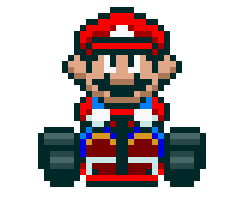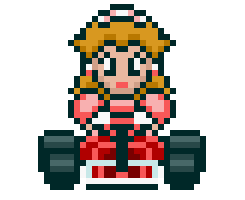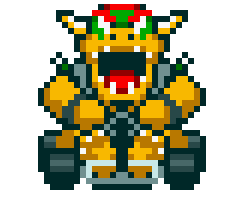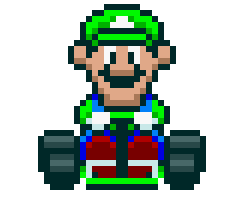Zod95 said:
Final-Fan said:
2a3a. Please direct me to those lists. More importantly the development costs one, I presume we can agree to use VGC software numbers unless you say otherwise.
|
I couldn't find a list with 50 games. This one seems quite reliable and it has 27: http://en.wikipedia.org/wiki/List_of_most_expensive_video_games_to_develop
Anyway, do you see any Nintendo game in there? I don't. As for the best sellers, in the top 27 I see 23 Nintendo games! See the contrast? Same thing when we look at games that qualify under my requirements. I just prefer to use them because I believe money isn't everything and that a dev can do great deeds with small amounts of money (Nadeo is a good example of that). So I prefer to assess the commitment of a dev and the depth of a game through their outcome in regards to objective parameters (in order to keep tastes aside and keep me lucid in the analysis). But I can't deny money is a more wide criteria and certainly shows commitment (although depth will depend on how well the money is spent).
In conclusion, I think Nintendo is very competent but also very greedy. I prefer to put my money on games that are, above all, games...rather than on finantial vehicles to fill the pockets of shareholders that won't reinvest it back in the industry. I honestly prefer Sony's and Microsoft's games. But even if I prefered Nintendo's, I would think twice before putting my money there.
Final-Fan said:
2a3b. I've made claims I've backed up. Specific claims about depth in a Metroid game. Aside from the ONE THING I said about game reviewers possbily having evidence of MP's depth in their reviews, what do you have to say about MY OWN arguments for its depth? You talk about my burden of coming to you with stuff to back up my claim, but when I've done so you haven't even addressed it!
|
What arguments? I had noticed none. Now I went to see your ealier comments on Metroid Prime and I can't believe this is what you call arguments: "That is a game with very good graphics for its day. It has a great atmosphere and huge levels that all interconnect. It has a very deep backstory that can be investigated by players that choose to examine the environment around them and see the clues and records of what has happened, as well as find out all about the flora and fauna. This information can be reviewed after being seen by the player at their leisure. It has a good combat system that was very original and very different from earlier Metroid games (which were 2D side scrollers while Prime is 3D and first person)."
Please tell me this isn't it...that you really have arguments that I somehow skipped.
Final-Fan said:
2a4b2.
I don't think you're lying but I would like to double check this (MP area); please show me where you got this information.
|
6th result on google (and I couldn't trace it in the link): https://www.google.pt/search?q=metroid+prime+map+size&hl=pt-PT&source=lnms&sa=X&ei=MkCBUrfJBMmS7AbZ94GYDA&ved=0CAgQ_AUoAA&biw=1680&bih=949&dpr=1#hl=pt-PT&q=metroid+prime+km2
But I admit this is not reliable, specially because there is a "..." between "Metroid Prime" and "100 km2". Anyway, it's like I said, if it was really big the internet would tell us the number.
Final-Fan said:
2a4b3.
The category in question became SO narrow that it's not surprising that Nintendo may simply be a developer that doesn't do that sort of game regardless of willingness to "work hard". Not all developers, even the really big ones, do all sorts of games. How many Pokemon-style games does EA make? How many kart racers does Microsoft have under its belt?
|
Do you think that's fair? I present you 9 different requirements and ask for you to tell me 10 Nintendo games that fulfill ANY of those. You present me 1 requirement for each dev. I present you generic requirements and you present me "kart racers" (within the racing genre, within the kart type) and "Pokemon-style" (even more specific!)? Not to mention that Nintendo has many more games released than EA or Microsoft.
Still, I can tell you about Spore (Pokemon-style) from EA and Joy Ride (kart racer) from Microsoft. Even within your insanely hard criteria, I'm able to find results.
And when you say "Nintendo may simply be a developer that doesn't do that sort of game", I ask you then: what sort of game? As far as I know, you have 9 different requirements to explore (not just 1) and none of them is about a specific genre (they are all generic). So, no matter the niches Nintendo is in, everything would be possible. Fully editable levels can be on action games like inFamous 2, platformers like LittleBigPlanet, driving games like TrackMania, etc. Same thing for simulating gameplay, area bigger than 300km2, online with more than 100 players at the same time, etc. There's no excuse.
Final-Fan said:
2a4b4. I'm sorry to disappoint you but of the hundreds of Nintendo games I've played a relative handful. I've played many Mario games, and Zelda, a couple Pokemon, etc. but I haven't played Baten Kaitos, haven't played Eternal Darkness, haven't played most of their games. And I don't perfectly remember them either.
|
You don't need to remember them perfectly. If you've played them, that should be enough for any of my requirements to immediately ring the bells for any of the Nintendo games you've played. Moreover, if you're a Nintendo fan, you certainly know about plenty of Nintendo games you didn't play. That should be quite a knowledge.
Final-Fan said:
Actually, though, you could say that Mario Paint has editable levels. See? I'm adding to this all the time!
|
You could only say that if they are fully editable and if they are really levels. Do you think a paint is a level? Try again.
Final-Fan said:
2b1. You're saying making a single game with 100 different characters with player statistics that are minutely different, is much harder than making 100 distinct mini-games? I'm sorry but that is delusional. The work put into adding another 100 characters with minutely different stats is relatively minimal vs. making another 100 minigames. Heck, a game like Final Fantasy Tactics RANDOMLY GENERATES such characters! The FIFA game (for example) simply has them locked into a certain set. Would you say it's accurate that FFT has an infinite number of playable characters, or at a minimum, thousands upon thousands to whatever limit is defined by the number of variables that goes into character generation? How much extra work does that mean Square put into its game versus having a set stable of characters you can recruit, say 30?
|
Now you start to understand why is there a lower limit but no differentiation at all to whether they are 100, 1000 or even infinite. I defined that requirement not only because of the work it demands to make hundreds or thousands of different stats but also because, if it was really in just 1 game, that would imply the game is deep and hard to make (a dev would never make such an effort if the title wasn't to be strong on most of the other gaming aspects too). My requirements are designed in a way to guarantee at all costs the product demanded hard work. They are not infallible, but I did the best I could. Having that said, now it's easy for you to understand why making hundreds of tiny games isn't as impressive.
Besides my requirements (objective outcome parameters) and developments costs, another insteresting metric would be man-hours spent. But I guess that's hard info to get from most of games.
Final-Fan said:
2b2. For example, one Brain Age game advertises having 50 different Sudoku puzzles you can do. Surely that is pretty similar to having 50 different soccer players you can play. And obviously there is more in the game than just Sudoku puzzles, enough to pass your limit.
|
First fallacy: 50 puzzles are sort of levels, not gameplay variants. Second fallacy: you can't add 50 from one game and some more from other game...until you make 100. Like I told you, the point of the requirement is to get to hundreds of different gameplay variants in 1 SINGLE gameplay so that we know that the gameplay has depth and it was hard to make (it's a big rock, not sand like the hundreds of tiny games).
4. My opinion is: SA1 is the best platformer ever and SA2 is the 2nd best. So, in my opinion, Mario Galaxy is not superior at all. But you're right, everyone is entitled to his/her own opinion.
|
2a3a.
I'm willing to believe that list is accurate in its numbers but it is extremely incomplete. $2 million may have been a bigger budget than any other game made in 2000, maybe not; but certainly many games made nowadays exceed that cost, inflation adjusted. One of many examples of Nintendo games I am sure exceed that cost is Super Mario Galaxy, but I cannot cite official numbers backing up this assessment. All I was able to find of SMG's budget was a person here on VGC that claimed that in E3 2009 Nintendo said they'd spent $20 million on Super Mario Galaxy. If it was 20 million, that would be less than half of the Halo 3 budget reported in that list, a game that came out at around the same time. On the other hand, SMG is not multiplayer, and not an "HD" game, both of which add a lot of cost to game development.
Note: It was estimated by a website that average quality Wii games turned a profit by 400 thousand units sold, and a Nintendo representative said they profited well before 1 million. This leads to estimates that those Wii games could have been budgeting 2 to 4 million dollars. Obviously Nintendo could expect to sell more than half a million units of their flagship title and budget more. Without more information I can't say exactly where Nintendo's biggest Wii games land on that list but I can confidently say it's not at the bottom.
2a3b.
I'm sorry if "great atmosphere" is something that can't be converted easily into numbers for your mental well-being. But do you deny that, if it is true, it can contribute to a game being "deep"?
Since I'm talking about this, let me clarify a couple of things: one, I reserve the right to add more evidence of depth if I choose; two, the comment about the "originality" of the combat system was less about depth and more in response to your claims of Nintendo being a lazy developer; three, a good combat system only contributes to a game's depth IMO by keeping you immersed in the game—if you are being annoyed by a clunky combat system then you are being thrown out of the game experience; four, good graphics alone don't make a game deep but it can enable depth with good artwork, creatures, level design etc. that combine to create a deep gameplay experience.
2a4b2.
I was able to use the "view cached" option to see that the 100km was talking about a completely different game, Brütal Legend. I don't blame you for not knowing how to do this, but if you had PAID ATTENTION to the result you found you would have known that the result was on Metroid Prime 2: Echoes and NOT the original Metroid Prime that I was talking about.
2a4b3.
I think I'm not doing the same thing. I'm showing examples to prove a point, very specific examples that can be easily double checked by you. This is only illustrated by the ease with which you pointed out to me that my examples were in fact wrong! (With Joy Ride. Spore isn't a JRPG, and I don't mean becasue EA isn't a Japanese company. Actually, is it an RPG at all? It's really not much like Pokemon at all IMO, and I'm not sure why you thought it was.)
On the other hand, you tell me several qualities (or quantities) that a game can have, some of them very hard to reliably research, and challenge me to a list war, with the implication that you "win" the argument if I don't run out and do a shitload of difficult research.
Simulators can be considered a genre IMO. Train simulators and flight simulators are obviously vey different games but it's they're different things in the same type to me.
Let's go back to your original list.
1. "foto-realistic environments"—Originally I took this to mean realistic graphics. Now I know that you meant "environments based on replicating a real life area". I think this is a retarded way to judge the quality of a game developer, but fine: Ken Griffey, Jr. Presents Major League Baseball. I believe I previously mentioned Waialae Country Club True Golf Classics. Also, as I just found out after writing in point 9 of this list, Goldeneye 007.
2. "fully editable levels"—Another dumb way to measure the quality of a game developer, and extremely difficult to research if you don't already know the answer.
3. "simulating gameplay" as in simulating real life activities or things like trains. Can I count Ken Griffey again? Nintendo made several of them.
4. "area bigger than 300km2" difficult to research
5. "gameplay with at least 100 variants (players/characters/cars/etc. behaving differently according to their skills/specs)" dumb measure of quality because of the fact that not all types of game call for this kind of multitude of similar-but-different "variants". I think this is also a pretty hard to research quantity for many games, however it's just occurred to me that when it comes to sports games you can cheat a bit. Let's take Ken Griffey Jr. again. Based on the Wikipedia article, there appear to be at least least 27 teams in the game. Since you need 9 players on a side in baseball, it can be presumed that the game has at least 9x27 players. Boom, hundreds. NBA Courtside 2002 also qualifies.
6. "content expandable with features created by gamers (area, levels, objects, game modes, etc.)"—I believe I already mentioned Mario Paint; after looking at the original condition I can say that it definitely qualifies. And from what I've heard of Wii Music it does as well. But I think this is another one that would be hard to research; I just happen to know a couple that fit.
7. "online matches with more than 100 players at the same time"—I guess you mean hundreds in the same game, instead of hundreds online in general. Why is this a measure of game quality? And how am I supposed to research this? I can know about games like this through reputation like MAG and Warhawk, but if I don't already know about it how can I find out?
8. "massive motion capture movements of actors"—This is a lot like the "photorealistic" environments quality, and at least as retarded a way to judge a game developer. And even harder to research, at least when it comes to "this game has realistic humans acting realistically in the game but how can I tell whehter they used motion capture?" NBA Courtside 2 Featuring Kobe Bryant had motion capture, but I don't know whether it was "massive" enough for you.
9. "story performed with character replicated from reality (bodies, movements, faces, voices, life habits, etc.)."—I don't see how this could possibly reflect a game maker's quality, But Ken Griffey Jr. steps up to the plate once again. Goldeneye 007 had some too.
As you can see, I obejct to at least half of your criteria on the basis of difficulty of research. Many of your criteria are slanted towards specific genres. For example, a "realistic" sports game would be much more likely to have hundreds of different players than a fictionalized one. When Nintendo did do franchised sports games, they had as many "gameplay variants" as anybody. In fact, KGJMLB "was groundbreaking and had a long list of features for its time", according to Wikipedia. But Mario Golf doesn't need to have 1000 different golfers when 950 of them are going to be Goomba #107 or Toadstool #93 or whatever. If you'd like to compare fictional-character sports games, we could try Super Mario Strikers versus Mega Man Soccer. I can't find out the comparative roster sizes quickly via the Internet, but I could go fire up my copies since I actually own both of those games, if the results would actually be valuable. I don't want to do that much work to find out you think it's irrelevant.
2a4b4a.
Au contraire, my knowledge of Nintendo games is most certainly not encyclopedic. You overestimate me, which is both flattering and unexpected. In fact, most of the matches to your criteria listed above were found by going through lists on Wikipedia and then following the links to games that seem like they could plausibly match. Even though I'd played Goldeneye, I wasn't sure its game areas were real life locations until I saw confirmation on Wikipedia. And even though I obviously knew that it featured characters from the movie who are obviously real people, I didn't think about the fact that that fit your criteria until while I was writing this post.
2a4a4b. "Do you think a paint is a level?"
I don't even know what you're trying to say here, but I can tell for sure that you don't know what I'm talking about. Mario Paint fits the criterion of creating content, in this case by: composing music; creating an animation that you can play back at various speeds, with sound effects; yes, making a painting (which is totally your own creation, not like a coloring book or whatever); and more.
2b1.
Actually, no, I don't. To get 100 players with different stats all you have to do is plug different numbers into a character creator, or in FFT's case randomly generate some. To get 100 minigames, you have to actually make them, even if they are simple. That's not to say that a lot of work doesn't go into making a lot of characters in a game. In Final Fantasy games you often have a huge number of players and a lot of work does go into making them all individuals with their own history, presonality, appearance etc. And the Gran Turismo series puts a lot of work into modeling a bajillion different cars. But the number doesn't prove that work happened. You have to look into the game, know it, see the work that was done. But that's not as objective.
2b2.
You misunderstood me. There isn't a "Sudoku" Brain Age game, and ten other Brain Age games that I was lumping together. There was one Brain Age game I was talking about that had at least 50 Sudoku puzzles and all the other stuff.
4. I thought about responding to this, but there's nothing to say.

























































 ; - ) : - ) : - ( : - P : - D : - # ( c ) ( k ) ( y ) If anyone knows the shortcut for
; - ) : - ) : - ( : - P : - D : - # ( c ) ( k ) ( y ) If anyone knows the shortcut for 



























